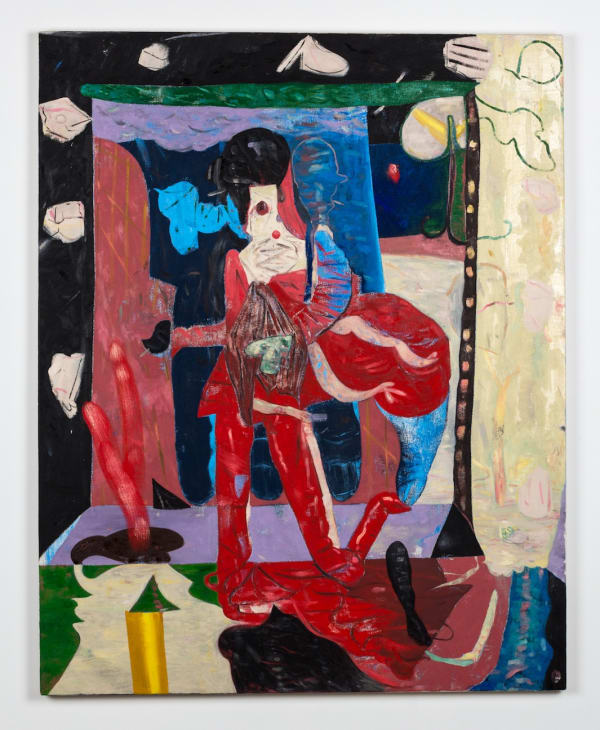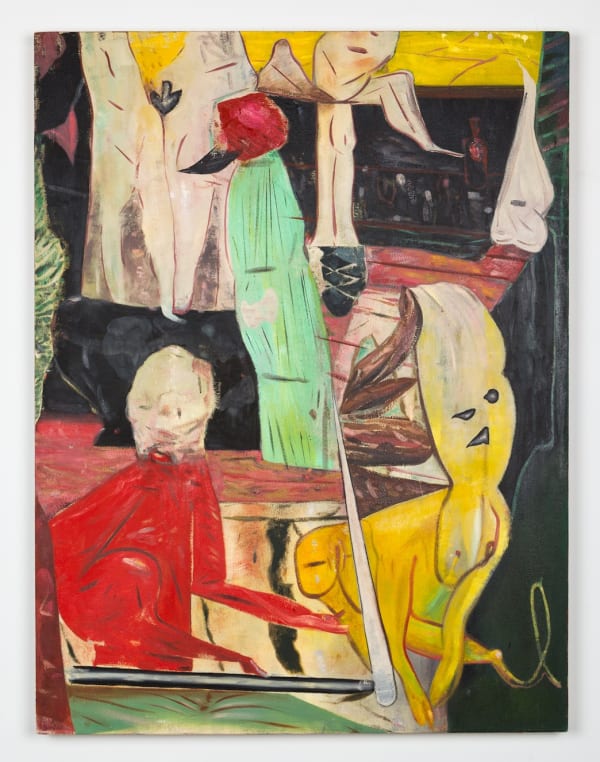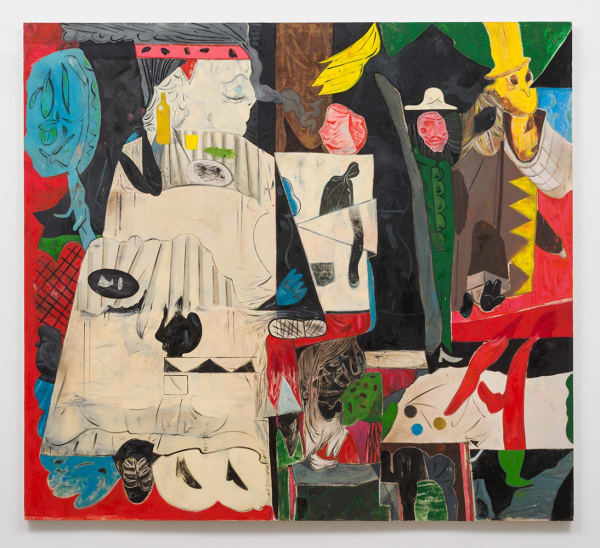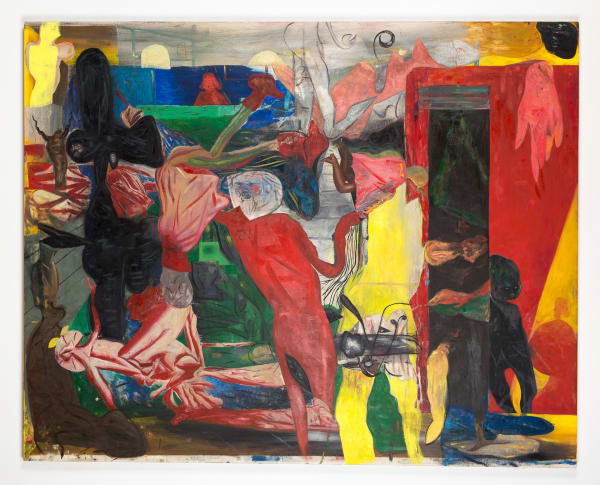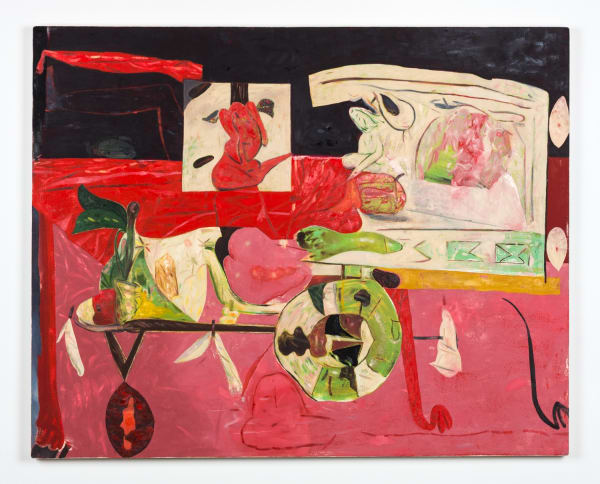Scott Anderson’s work creates a fresh visual language with whispers from late modernism masters such as Robert Rauschenberg and Francis Bacon. His compositions demonstrate a layered and balanced intricacy within his signature figurative abstraction that continues throughout his work like a subconscious narrative, familiar yet unknown. The unique sense of texture and colour in Anderson’s paintings adds to his already singular style. It is truly incredible to have taken a medium like painting — almost as old as art itself — and reimagine its capabilities and aesthetics until they are moulded and transformed into each extraordinary and endlessly enigmatic piece.
Earning his MFA at the University of Illinois Urbana-Champaign, Scott Anderson currently lives in New Mexico where he is Assistant Professor of Painting & Drawing at University of New Mexico. His work has been exhibited nationally and internationally at prominent institutions like the Museum of Contemporary Art Chicago, Beers Gallery London, and Denny Gallery in NYC, where he recently had a solo exhibition. Join us as we discuss with the artist his creative process on the canvas, the doubts you feel as an artist, and the inspiration for the title of his solo show “Streaming by Lamp and Fire.”
Text and Interview by Christina Nafziger
AMM: Let’s begin with your roots as an artist. Where did you develop your undeniably distinct style? Has artistic expression always been a big part of your life?
SA: I’ve always drawn a lot, even as a child. My parents encouraged me to pursue something in the visual arts, which is a somewhat unusual thing for parents to do, so I was lucky in that respect. It still took me a while to realize what it meant to be an “artist”, and maybe I still don’t really know for sure, but I’ve been committed to the idea for a long time. I never really thought of doing anything else.
The first artist that I was really attracted to in college was Robert Rauschenberg. I think it all goes back to him. The collage and the patina of detritus mixed with conventional art materials was so seductive and still is. I don’t think I really knew exactly why I was so hooked on that work back then, but in retrospect I think it has something to do with a kind of complicated, almost contradictory relationship his work had to serious painting at the time (thinking here particularly of the combine paintings from the 50s). He seems to long for the “romance of painting” but he knows too much to abandon irony, humor, and a sense of distrust of the myth of the medium. I really sense that tension and I identify with it – always have. Even as I think of other painters now that are more straight forward in their approach to figuration, narrative, or even abstraction. I think I still filter all of it through a kind of scepticism I’ve always associated with Rauschenberg.
AMM: We’ve noticed there is often a distinct colour that unifies the already bold palette within each piece, such as deep reds or bright yellows, that frequently show up in multiple paintings. Can you talk a bit about the role colour has in your process as well as in your body of work?
SA: When I was young, I was coming to painting as a draftsperson, so I was terrified
of color at first. I love color now, but I still veer towards combinations that have a kind
of graphic impact. The paintings from the past several years have had a lot of black in them, which I think goes back to that drawing sensibility. It is also very rich, dense – even the whites or the areas of seemingly raw canvas have a chroma and patina, and the paintings feel a little like frescoes that need to be cleaned or overbaked bread. I also think that my color palette has a lot more to do with historic European painting than say, the spectrum of contemporary visual culture. I like the contradiction of the historical chromatic and material signifiers marbled with an approach to narrative that is more dependent on the current moment.
AMM: With such intricate and multifaceted layers within your compositions, how do you begin one of your paintings? Is there a larger narrative that connects the actions within each piece?
SA: The narratives typically arise out of the process of painting. Sometimes they are completely fictional, but often are connected in some way to real memories I have, familiar figures, objects, or spaces. Every once and while I look back at work I’ve made over a period of time and identify reoccurring themes, but it’s not something I set out to do.
AMM: Do your works on paper feed in to your painting process, or vice versa? How much experimentation is done on the canvas and how much preliminary planning is involved?
SA: Almost every painting is made using a drawing as a model and almost every painting changes radically from that drawing. I’m completely willing to see what happens when a drawing simply gets scaled up and translated into new materials, but I’m usually unsatisfied with where that leads. Its cliché, but I tend to need to wipe out, or paint over large swaths of the painting at some point to have it make sense to me.
AMM: Your paintings are layered not only compositionally, but materially as well. What media do you use to create your multifaceted paintings?
SA: I’ve been drawing on the canvas with oil crayon, charcoal, or pastel to start a painting lately. Not every one of them, but most. I’ll also sometimes use ink or acrylic to start something. Basically, I need materials that set up quickly so that I can use them in a kind of “low stakes” sort of way. All of that stuff usually gets covered up by your standard battery of oils, mediums, and solvents, but I think it adds some kind of vitality to the materials even if it’s buried. I’ll also do stuff like mix sawdust, graphite, or small amounts of fine sand in heavy-bodied oil paint too, but all of those are moves painters have been making for a long time. They are very traditional paintings in terms of materials.
AMM: Congratulations on your solo exhibition earlier this year at Denny Gallery in NYC titled “Streaming by Lamp and by Fire.” Can you tell us a bit about the selection of your work exhibited?
SA: Thank you! I’m very proud of that show. The title uses keywords belonging to three separate time periods. “Streaming”, in this case, references the current moment of rapidly downloading content via the internet, “Lamp” has the modern and immediately pre-modern eras covered, and “fire” belongs to the broadly primitive. The metaphor for painting here is basically doing something by the light of three different periods simultaneously. It is also proposing that the something being done is happening in three different keys simultaneously, if streaming is about entertaining, a lamp is studious, and a fire is ritualistic. Seems to me the fate of the contemporary painter is to channel multiple moments of painting’s history and its functions all at once when they go to make a painting – or maybe they are all there whether the painter is conscious of them or not? I actually enjoy thinking about how many of them are in a painting and the more at odds they seem with one another, the better. That is what the title refers to, which is a broad theme that just about any painting I make could fit into.
AMM: There seem to be influences of Francis Bacon in your fleshy, figurative abstraction. Is this an artist you find a connection with? Would you say the figure itself is often the subject of your work, or do these figures represent a more psychological manifestation?
SA: I love Francis Bacon and I’m sure his paintings assert themselves as influences, even if I don’t deliberately seek them out as such. I do think about one of his contemporaries, R.B. Kitaj, quite a bit though. Like Rauschenberg, who I mentioned earlier, that group of British painters who came to prominence in the periods between the “high moderns” and the pop artists occupied diametrically opposed sectors of the art world with single bodies and unified bodies of work. They were like saints supplanted on pagan demigods, or Lutherans, or efficiency apartments. The figures in my paintings are stand-ins for all sorts of things like the material of paint, other paintings, the landscape, architecture, as well as elements playing the role figures have in paintings throughout the history of the medium. I guess the figures are in service of painting more generally as opposed to figurative painting specifically.
AMM: With elements of the surreal prevalent throughout your body of work, does stream of consciousness or the subconscious have a role within your process?
SA: I definitely think so, though it’s cued by the painting or the process of making the painting rather than it all coming from my head, if that makes any sense. I think the way I interact with the object and materials is far more likely to produce something fresh than my limited imagination.
AMM: What aspect of your practice do you feel is the most challenging? Can you tell us about a moment in your career as an artist where you had to overcome a particularly difficult obstacle?
SA: I think a lot of artists would relate to the fact that you feel like you are often making work with a feeling of near certainty that no one will ever care about it but you. No one may ever see it but you. Modern technology kind of erases the latter portion of that sense of anxiety but not the former. I’ve found that I have to be at peace with that or I might risk just chasing trends, which almost always fails (and is super boring). When I moved to New Mexico from Chicago I had an intense period of anxiety about all that. I felt isolated and I had largely lost the abilities I once had to detect if the paintings were resonating or not. Despite the intense light of the Southwestern US, I was painting in the dark, so to speak. The work changed. I changed as a painter, and I feel pretty good about it now, but there were a lot of reasons to quit for about 5-6 years.
AMM: Having lived in Kansas and Illinois for your education, what brought you to you current location, New Mexico?
SA: I moved to New Mexico to accept a teaching position, having never been to the area before the job interview. It was such a stark departure from the Midwest, which I felt I really needed at the time. New Mexico is so beautiful, severe, and specific. As a place, it keeps me from feeling neutral. I don’t really feel like I belong here, which can be bad, but I think it is also useful. Living here is generative for now.
AMM: What aspect of your life do you feel inspires your artistic practice the most?
SA: Love and devotion to those people closest to me, particularly my wife and daughter, but also love and devotion to painting. I believe in painting and paintings ecstatically. I don’t make work as a critical gesture, but to affirm my love for something that was great to begin with, by doing it over and over again.
